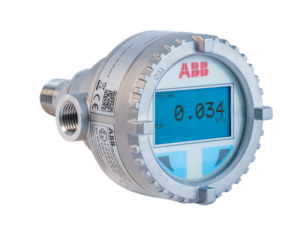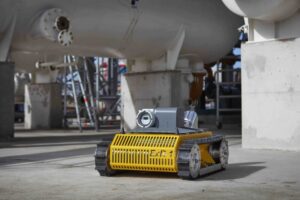Measuring pressure is fundamental in the control of most industrial processes. As a key indicator of quality, consistency and safety, pressure needs to be measured as accurately and as widely as possible. Many of today’s pressure transmitters on the market are highly capable devices found in a wide variety of demanding applications and industries. While offering high performance, these high specification devices often come at a premium price and require extra time to customize and deliver.
But what if your application does not require the highest specification levels? The new ABB PxS100 range fits the bill. It provides all the features and functions you need and none of the ones you don’t. Flexible and adaptable, it gives you the device you need in a fraction of the time it takes to specify, adapt and deliver a complex unit.
We talk to David Bowers, Product Manager Pressure and Process Flow at ABB, about the new range and the key benefits it can offer.
Describe the PxS100 range in 20 words or less?
The PxS100 range offers the essential features and the same accurate sensor technology you would expect from our higher-specification transmitters, at a competitive price.
Tell us more, what key benefits does it offer customers?
The PxS100 range is available in two versions. The PGS100 is for measuring gauge pressure, while the PAS100 is for absolute pressure measurements.
Both are lean transmitters that have been cleverly designed to offer all the essential features expected in a pressure transmitter, with the ability to withstand demanding environments including hazardous areas. The result is a truly versatile product that can be delivered in a fraction of the time typically associated with ordering a pressure transmitter. With a variety of customisable options, the range gives customers the opportunity to make an optimal purchase decision without having to compromise.
This PxS100 range is the go-to competitive solution for most applications, and the real beauty is that they come with the same high-performance accuracy and range you would expect from any of the superior specification pressure transmitters. If you want to upgrade the sensor, for example, it is available blind with no display, normal display or a high-resolution display and HART. An optional high definition backlit display enables excellent readability of the reading even in dark environments.
Where can the transmitters be used?
The transmitters can be used in all sorts of applications across multiple industries. The gauge and absolute sensor variants cover five different measurement ranges spanning applications from 40mbar (16in H2O) up to 100bar (1450 psi). A compact stainless-steel housing enables all PxS100 transmitters to be used in conditions of high-humidity or high dust concentration in the air.
The design has also considered the hygiene requirements in food and beverage and pharmaceuticals applications, with a choice of ingress protection levels from IP66 to IP69K making the transmitter suitable for hygienic environments. Its robust design means it can be used in the most demanding environments including in hazardous areas.
Is it simple to set up and to use?
One of the key drivers in the development of our instruments and analysers is to make them as easy as possible to operate. For this reason, the PxS100 transmitter range uses an Easy Set Up menu which applies the same intuitive logic as a smartphone. The menu enables users to establish the main device parameters quickly and easily, significantly installation and set-up and eliminating the risk of potential errors during commissioning and operation.
The same simplicity has been applied to configuring and communicating with the transmitters. The transmitters can be ordered with 4..20 mA analogue protocol or HART digital protocol. The HART version allows an easy-set up configuration. Both the PSG100 and PAS100 are also fully compatible with asset management software such as ABB’s FIM (Field Information Manager). Enabling users to perform a range of remote access and configuration functions, ABB’s FIM tool eliminates the need to physically visit the device, which could be located in inaccessible or hazardous areas. The availability of drivers like DD, DTM and FIM further expands the configurability of the transmitters from the local unit up to handheld HART devices and PCs.
The transmitters are also easy to install. A double-threaded process connection which can be used with a huge range of adapter accessories ensures maximum compatibility by enabling the transmitters to meet the installation requirements of a range of different industries with different locations, environments and requirements. Using ABB’s range of adaptable connectors and flanges, the PxS100 series can be rapidly configured to accommodate hundreds of different requirements.
How has ABB managed to speed up the delivery of the pressure transmitters?
The thing that makes it possible to fit in a variety of settings are the fittings. Options such as interchangeable threaded connectors and flanges enable ABB’s nationwide network of stockists and value providers to stock product without the need to make a bespoke order. This means customers can order a device to their own specific requirements directly from either their value provider or ABB and expect delivery within a few days.
The additional benefit is that ABB has entrusted the data tagging and customisation of the transmitter’s electronics to the Channel Partner/ Value Provider. The Channel Partner will print the Data Tag – serial number and customer details on labels. It is also possible for the Channel partner to customise the electronics including adding a partner address and customer services number.
Will it need replacing as digital instrumentation is rolled out?
The PxS100 range has been designed to meet the trend for increasing digitalisation and incorporates all sorts of features that make it easy to obtain vital information online. One key feature is the inclusion of QR codes. There is a ‘static’ QR code printed onto the device’s name plate. When scanned using a smartphone or tablet it will give direct access to the PxS100 series webpage where manuals, instructions and any other related documentation can be retrieved.
The device can also offer Digital Diagnosis Access (DDA), using dynamic QR codes which are activated by an error or when a faulty condition is detected, such as the process being outside the measuring limits. Dynamic QR (DQR) codes take the advantages of QR code technology one step further. Unlike QR codes which are static and can only display a limited amount of predefined, hard-coded information, DQR codes are able to reflect the real-time status of the device in question. Scanning the dynamic QR code on the device will bring up diagnostic information, possible causes and instructions on how to correct it all in clean clear and detailed text.
Many customers have issues with arduous process conditions. How does the transmitter solve this?
In the past, maximising protection meant having a top of the line high end pressure transmitter with costly protective coatings or materials.
ABB’s solution to this is diaflex coating. Diaflex is a flexible diamond coating that provides a comprehensive safeguard against abrasion and other harsh operating conditions that can quickly destroy pressure transmitter diaphragms in unprotected devices. With a Vickers hardness value of 4000HV, it exceeds the resilience of other forms of protective coatings such as gold and ceramics, without compromising pressure transmitter performance. This is due to its ultra-thin thickness, which allows the springiness, or flexing, of the metal diaphragm to be retained, enabling it to be used for applications with process temperatures ranging from -100°C to 700°C depending on the fill fluids being used.
The transmitter also features our H-Shield technology. H-Shield resolves the issue of hydrogen permeation that causes galvanic corrosion in applications with dissimilar metals. If allowed to do so, hydrogen can pass through metal, potentially causing a bubble to form in the pressure transmitter diaphragm that can eventually destroy the transmitter. This issue has traditionally been solved by coating the diaphragm with gold. While effective, this method is very expensive and can be hard to work with.
H-Shield overcomes this, by allowing the use of stainless-steel material with Hastelloy with a protective coating. As well as being less costly, it offers much greater protection than gold, without affecting measurement performance.
Finally, how would you describe the PxS100 range in a nutshell?
The range provides all the features and functions you need. Flexible and adaptable, it gives you the right solution in a fraction of the time normally needed to specify, adapt and deliver a typical pressure transmitter.

 Instrumentation Monthly Test | Measurement | Control
Instrumentation Monthly Test | Measurement | Control










